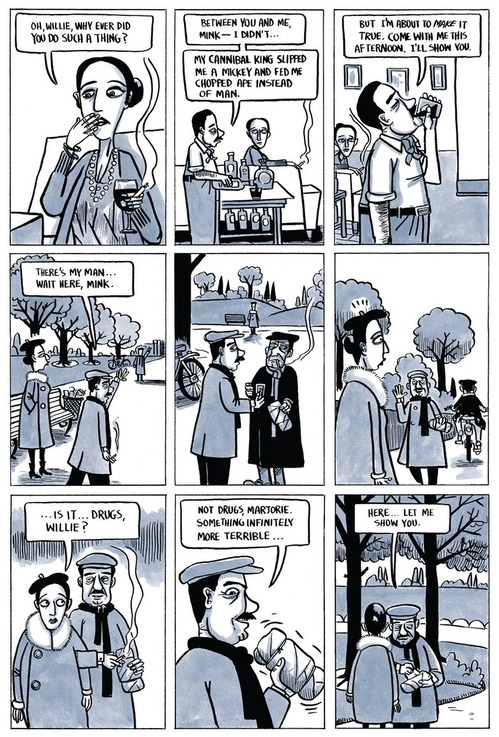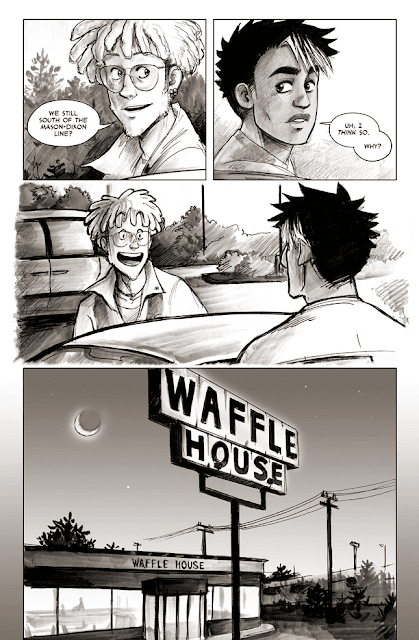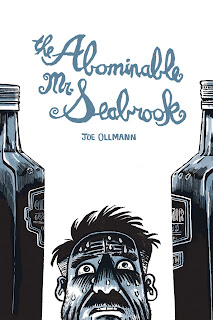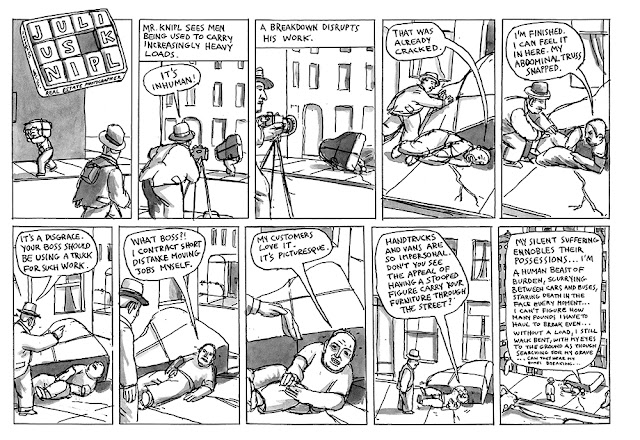As I contiune My Year in Comics, I describe, amongst other gems, the totally unexpected but welcome weirdness of Alex de Campi’s Archie vs. Predator, Charles Burn's X’ed Out and The Hive, Canadian writer and artist Joe Ollmann’s The Abominable Mr. Seabrook and E. K. Weaver's The Less than Epic Adventures of T.J. and Amal. As well, I mention two big disappointments, The Dark Knight III: Master Race (Frank Miller, Brian Azzarello, Andy Kubert and Klaus Janson) and Cinema Purgatorio (Alan Moore and Kevin O'Neill et al.).
Alex
de Campi’s Archie vs. Predator
Dark
Horse Comics and Archie Comics Crossover,
2015
The
title of this abomination says it all. The 1980’s action-horror
motif meets the ol’ Riverdale gang and carnage ravages their ranks. As always, the talented de Campi is merciless, and skewers tradition (in more ways than one). She also keeps a dandy of a feminist
subversive theme beating at the centre of this gory beast. The art’s classical, but the story is decidedly not.
No one is safe, least of all Veronica’s beloved “Archiekins”.
Pantheon
Books, 2010 and 2012
William
S. Burroughs’ Naked Lunch surrealism meets Hergé meets underground comics meets teen angst in the second and third parts of his
masterful and disquieting X’ed Out
trilogy. The first volume was Sugar Skull. Among the unnerving symbolism are pigs, worms, projected identities, and deformed monsters. It's also non-linear storytelling from first page to the last. Burn’s use of sex and
violence and emotional distance are exceptional and uncomfortable. Charles Burns is not messing around, and leaves a mark on the reader.
Ollmann has pulled off a balanced and honest depiction of the tragic journalist William Seabrook. Seabrook was a gonzo journalist before there was gonzo journalism, and somewhat worshipped by Hemingway’s lost generation because he was writing about his out-of-country experiences after living them. The early twentieth century traveler's notable accomplishments include abandoning every successful venture he took on, coining the term “zombie”, going on safaris, and witnessing voodoo
rituals firsthand. This biographal subject, however, is afloat in alcoholism from his formative years to his decline. Seabrook's fascinating-yet-cautionary tale is reminiscent of Jack Kerouac's meteoric literary career. Both writers go from open-minded adventurer to hardened and defeated alcoholic. Prepare to have your heart shattered to bits, faithful reader. Abominable isn’t always easy
to handle, but constantly enlightening and fascinating. Ollmann's treatment is exhaustively researched. In the appendix, Ollmann lists Seabrook's novels in order of preference. This is a noteworthy and thoughtful gesture for readers unfamiliar with Seabrook's opus.
 |
| Aw, William, put down the drink. Agh... |
Noteworthy (read: rather brilliant) comic-book artist and writer Seth has called fellow Canadian Joe Ollmann "criminally underappreciated", and there’s no argument from my corner. Ollmann depicts the everyday human struggle, from the mundane to monumental, follows life-like and very flawed characters and depicts mercilessly realistic settings and situations. All of this puts Ollmann in the same room as American comic-book writer icon Harvey Pekar, in my opinion.
Required reading of Joe Ollmann’s oeuvre includes Mid-Life, Science Fiction, and Happy Stories About Well-adjusted People.
Julius Knipl, Real Estate Photographer: Stories, Ben
Katchor (writer and artist), Michael Chabon (contributor)
Little,
Brown and Company, 1996
The plight of loner and urban observer/historian Julius Knipl is indie-art-meets-urban-angst. Katchor is sentimental, quirky and offbeat. At the end of some
tales, about doomed storefront businesses or solitary characters or the urban infrastructure as a living creature,
your heart aches. Katchor makes the reader long for the fleeting moment, the
transient urban structure, as though it is part of them that is lost.
Titans Hunt, Dan Abnett (writer)
et al.
DC
Comics, 2016
Abnett
Stephen-Kings (Is that a verb? Because I just made it one. - The editor) this whole DC Comic
rebirth/reboot, with great success. Abnett uses the King's tried-and-true techniques such as the recurring nightmare motif, a dastardly villain crossing the country in search of the heroes, and a cast of disparate characters who have seemingly never met but unite to figure out just
what the hell is going on. Why can't Wonder Girl, Aqualad, Robin, Speedy and the remainder of the heroes remem this healthy influence of Dean Koontzesque supsense building, and
seductive exploitative art, along with the traditional superhero attitude of let’s-fight-and-figure-out-why-afterwards, Titans Hunt is a
great and unexpectedly enjoyable yarn. This is sort of tiding me over until I can find season three of Young Justice, a remarkable show that I learned (very recently) has returned, much to its cult following's delight.


Totally
Unexpected Beauties
Wonder Woman ’77 Volume One trade
paperback
DC
Comics, 2016
Marc Andreyko (writer), Drew Johnson, Matt Haley, and Cat
Staggs (artists)
Charming through and through, Andreyko’s weird lovechild of the
1970’s accurately depicts Linda Carter in all of her fine features, and feels like the network T.V. show. For those of us who watched Carter in her star-spangled tights the first
time, this book is a real delicious retread, and it's trippy for all its familiarity. As well, there's not a single budget constraint, because this is a comic book, my friends. For newcomers, this is a great conversion
camp to the cult of T.V.’s First Lady of Amazon Island.
 |
| Page from The Less than Epic Adventures of T.J. and Amal by E. K. Weaver. |
Iron Circus Comics, 2015
Indie-film-meets-comic-book-page in this stunning and
heartfelt debut from Chicago writer-artist E.K. Weaver. Two fellows,
T.J. and Amal, take a cross-country trek, a sure-fire art-house motif that
sings beautifully, from landscape depiction to quiet moments between two young
men, who are questioning where they are at in the world, and who may or may not
get together, and the secrets they carry with them. Beautiful in many
instances, this is the first creature of its kind I’ve seen.
Monstress Volume One: Awakening, Marjorie Liu (writer) and Sana Takeda (artist)
Image Comics, 2016
Lovecraft, anime and Tolkien blend like orchestral music in this beautiful saga with art that knocks you back. Lui spotlights a heroine the reader with a monstrous side whom the reader can get behind. There’s so much beauty in the painted artwork that you have to reread panels, or stare at them until you have had your fill. |
Image from Monstress Volume One: Awakening, Marjorie Liu (writer) and Sana Takeda (artist). |
Disappointments
Mark Waid’s The Unknown Volume One trade paperback
BOOM!
Studios, 2010
What
seemed like such a promising premise with heroine Cat Allingham falters badly.
Unlike, for example, Alex de Campi’s, Semiautomagic,
this is a lacklustre John Constantinesque character. Artist Minck Ooosterveer uses
every available opportunity to showcase the character’s bosom. However, Ooosterveer's style fails to make the protagonist beautiful. She's just stylized, unlike Michael Gaydos' renderings of Jessica Jones in Brian Michael Bendis' Alias series, where Jones appears beautiful in many instances, but not exploited for a (presumably imagined) male gaze. Erik Jones’ covers, on the other hand, do show Allingham as beautiful, but they are lurid and sexy and don’t match the
carpet (i.e.: Ooosterveer’s pencils inside the book). It’s like the writer had
a vision, the artists saw cleavage, and the result was a solid story with
unnecessarily exploitive art that undermines Waid’s considerable storytelling
talent.
The Dark Knight III: Master Race, Frank Miller, Brian Azzarello (writers), Miller, Andy Kubert and Klaus Janson (artists)
DC
Comics, 2015 to 2017
What
Miller did in The Dark Knight Returns and
The Dark Knight Strikes Again, he
does here again. And again. In this dystopia, Miller further deconstructs
Bruce, Clark, Barry and other DC Comics characters. While readers initially hope that
co-writer Azzrarello and artists Kubert and Janson will temper any possible
bloat in the narrative, this hope dims to nothing as the story runs amok. The Dark Knight just keeps rising again, and
again, ad nauseam. The momentum that builds is a tiresome, mundane exercise of
rattling the reader with progressively more outrageous depictions of comic book
heroes. It was better the first time around, and certainly better when Alan
Moore did it in Watchmen and, closer
to DC Comics fans’ hearts, better when Mark Waid deconstructed the whole works
in his brilliant Kingdom Come.
Cinema
Purgatorio, Alan Moore (writer), Kevin O’Neill (artist), and Kieron
Gillen, Garth Ennis, Max Brook et al.
What
started out at as a brilliant anthology series with four continuing stories in
a magazine style has devolved into a spinning of tires. Readers can’t leave
Alan Moore’s cinema literary conceit (a first-person narrative that involves a
different deconstructed film each time, shot through with arcane cinematic
history) any more than the characters in all the other stories can move on with
their quests. Most of these quests, in fact, involves giant monsters. I have nothing against giant monsters, but when three of the five feature stories about these beasts, it's just too much sugar. The early issues, up to about number six, are fine. However, once
the reader realizes they’re duped and the storylines are without end and, in
fact, repeating themselves, the book becomes decidedly a-one-trick-pony by
issue eight.















